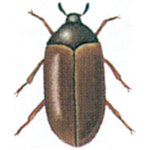
The animal world is not static as nothing in nature is. Species disappear and others emerge.
The brown carpet beetle (Attagenus smirnovi) is one of the relatively new animals in our animal life. It is native to Africa. In Europe it was first discovered in 1961, when E.S. Smirnov (hence the species name) found a species in Moscow. A few years later a few brown carpet beetles appeared up in Herlev in Denmark, and now they have spread throughout Europe and has become common in many homes.
The adult beetle is only 3-4 mm long, the elytra covering the abdomen are brown while the front of the beetle is dark brown or black.
The female lay about 50 eggs, the larvae are yellowish-brown and clearly articulated and they have a brush-shaped tuft of hair at the rear.
Like most other carpet beetles, they eat dry remains of animals and plants. They are about six months to become mature and they can attain a length of about 8 mm. Brown carpet beetles are originally tropical animals and they grow best at a temperature of about 24 degrees C. and can not multiply outdoors in Northern Europe.
The adult beetles are active animals and good fliers. If you have brown carpet beetles in the house, you will often find them on window sills where they go looking for light. On summer days they fly in the open and like this they find their way from house to house, but they usually spread by being brought about in goods, luggage or furniture. In residential buildings, they can spread through piping and other crevices.
Given how common the brown carpet beetles are in European homes, it is remarkable how few actual damages have been reported over the years. Usually the larvae live hidden in cracks and crevices where they feed on random organic matter, dead insects, seeds and crumbs.
Several other countries have, however, seen the brown fur beetle as an actual pest that lives up to its name and gnaws fur, wool and feather. They have also been known to cause damage to museums where they among other things can ruin insect and herbarium collections.
It is very difficult to completely prevent the occurrence of the brown fur beetle, but normally a frequent, thorough vacuuming of cracks and crevices will keep the number down to a reasonable level. One of the pesticides that are approved for this purpose can of course also be used for treatment of their living spaces.
Carpet beetle
The, so to say, “true” carpet beetle (Attagenus Pellio), is slightly larger than its brown relative. It is plain black with a few white spots on its elytra. The larvae resemble the brown carpet beetle larvae, but they grow a little larger in size.
The carpet beetle is an old Danish species, and can be found in many places outside our homes. In summer you can see the beetles in blooming plants where they eat pollen and nectar.
Eggs are laid mainly in birds’ nests and mice nests where the larvae can live on feathers, hair and other debris. The beetles can also fly in from outside and lay their eggs directly on woolen fabrics and fur.
The greatest risk of getting them in, however, are from birds’ nests in attics. When discovering damage to textiles, the same methods are used as those against clothings moths and other carpet beetles.




